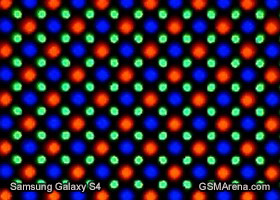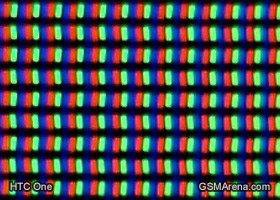Samsung Galaxy S4 review: Supernova
Supernova
1080p Super AMOLED display is what geeks' dreams are made of
One of the most important updates that the Samsung Galaxy S4 brings is the new 5" Super AMOLED screen of 1080p resolution. While it does have a PenTile matrix, the 441 ppi pixel density makes sure you won't be able to spot the hated cross-hatch pattern.

The 5" 1080p Super AMOLED is gorgeous
The defect wasn't easily spotted on the Galaxy S III either unless you looked from a closer-than-comfortable distance, and here it's as good as invisible to the naked eye. The design of the PenTile matrix has been changed too, so now green sub-pixels are twice as many as blue and red sub-pixels, and the arrangement is changed as well. This however matters little to anyone not armed with a microscope.


Samsung Galaxy S4 and HTC One screens up close
What you should take away from all this is that the final weak point of the Super AMOLED screens has been taken care of and the Galaxy S4 offers image quality like no other smartphone on the market. Its impressive contrast and almost perfect viewing angles make everything on the screen pop, regardless of your viewpoint.
The color saturation is beyond the reach of any LCD out there, which make even the dullest image appear remarkably vibrant. Still, if you are not a fan of the oversaturated look of AMOLEDs, Samsung gives you the option to tune down the saturation to more natural levels and enjoy the best of both worlds. There's a dedicated Adobe RGB setting that gets this done.
The brightness levels of the Samsung Galaxy S4 are about on par with the rest of the company's AMOLEDs, which is to say not very high. However, due to their low reflectivity, this doesn't affect outdoor performance. Keep in mind that enabling the auto tone setting in the screen option limits the maximum brightness to under 300 nits, so if that matters to you, you better keep it off.
| Display test | 50% brightness | 100% brightness | ||||
| Black, cd/m2 | White, cd/m2 | Black, cd/m2 | White, cd/m2 | |||
| HTC One | 0.13 | 205 | 1580 | 0.42 | 647 | 1541 |
| HTC Butterfly | 0.14 | 173 | 1200 | 0.45 | 501 | 1104 |
| Samsung I9505 Galaxy S4 | 0 | 201 | ∞ | 0 | 404 | ∞ |
| Samsung I9300 Galaxy S III | 0 | 174 | ∞ | 0 | 330 | ∞ |
| Sony Xperia Z | - | - | - | 0.70 | 492 | 705 |
| Oppo Find 5 | 0.17 | 176 | 1123 | 0.51 | 565 | 1107 |
| Samsung N7100 Galaxy Note II | 0 | 215 | ∞ | 0 | 402 | ∞ |
| LG Optimus G Pro | - | - | - | 0.41 | 611 | 1489 |
| Nokia Lumia 920 | - | - | - | 0.48 | 513 | 1065 |
| LG Optimus G | 0.14 | 197 | 1445 | 0.33 | 417 | 1438 |
| Apple iPhone 5 | 0.13 | 200 | 1490 | 0.48 | 640 | 1320 |
Of course, Nokia showed that a brighter AMOLED can do even better in direct sunlight, but the gain isn't as dramatic. The Galaxy S4 is a solid performer outdoors, although surprisingly not any better than the Galaxy S III, despite its slightly higher brightness. Perahps, the new Gorilla Glass causes a dash of extra reflections and offsets the advantage.
Sunlight contrast ratio
-
Nokia 808 PureView
4.698 -
Apple iPhone 5
3.997 -
Samsung I9300 Galaxy S III
3.419 -
Samsung Galaxy S4
3.352 -
Samsung Omnia W
3.301 -
Samsung Galaxy S
3.155 -
Nokia N9
3.069 -
Samsung Galaxy Note
2.970 -
HTC One S
2.901 -
Samsung Galaxy S II
2.832 -
Samsung Galaxy S II Plus
2.801 -
Huawei Ascend P1
2.655 -
Nokia Lumia 900
2.562 -
HTC One
2.504 -
Sony Xperia Z
2.462 -
Samsung Galaxy S III mini
2.422 -
Motorola RAZR i
2.366 -
Samsung Galaxy Note II
2.307 -
Apple iPhone 4S
2.269 -
HTC One X
2.158 -
Nokia N8
2.144 -
Oppo Find 5
2.088 -
BlackBerry Z10
2.051 -
Apple iPhone 4
2.016 -
Sony Ericsson Xperia ray
1.955 -
Samsung Galaxy Camera
1.938 -
HTC Butterfly
1.873 -
Sony Xperia V
1.792 -
Sony Xperia U
1.758 -
LG Optimus 4X HD
1.691 -
HTC One V
1.685 -
LG Optimus Vu
1.680 -
HTC Desire V
1.646 -
LG Optimus G Pro
1.552 -
LG Optimus 3D
1.542 -
Nokia Asha 302
1.537 -
Nokia Lumia 610
1.432 -
Gigabyte GSmart G1355
1.361 -
HTC Desire C
1.300 -
LG Optimus L7
1.269 -
LG Optimus L9
1.227 -
Meizu MX
1.221 -
Sony Xperia E dual
1.203 -
Samsung Galaxy Pocket
1.180 -
Sony Xperia tipo
1.166 -
Samsung Galaxy mini 2
1.114
You can find all about our display testing routines here.
Controls
Samsung has a bunch of new sensors scattered around the Galaxy S4's body, but the general layout of controls is largely unchanged.
Below the display you get the same three keys as on the Galaxy S III - capacitive Menu and Back buttons and a regular press Home key.

The usual set of keys sits beneath the display
There's some extra functionality upon a long press too - the Menu key handles Google Now, while the Home key brings up the task switcher. Pressing and holding the back button brings the side bar for the Multi-window feature (if it's enabled), and if you click the home key twice the Samsung S voice virtual assistant kicks in.
Above the display we have the earpiece, as well as a bunch of sensors. The traditional ambient light and proximity sensors are joined by an IR gesture sensor, which enables the cool Air gestures in applications such as the web browser and music player. There's also a 2.1 megapixel front-facing camera for video calls and a status LED up there.

It's getting crowded above the screen
The left side of the Samsung Galaxy S4 features the volume rocker, while the power/lock key is on the right. Unfortunately, despite the proper camera upgrade that the Galaxy S4 got, the new flagship is still missing a dedicated camera key. You can use the volume rocker for snapping photos, but it can't quite match a two-stage button.



Once again our shutterkey prayers have been left unanswered
The top of the Galaxy S4 features the 3.5mm audio jack, the secondary microphone and the IR blaster that allows you to use the smartphone as a remote control for your home appliances. There's also a remote control app with a pretty rich database preinstalled, so the functionality is available out of box.


The 3.5mm audio jack Is joined by a microphone and an IR blaster
The microUSB port at the bottom is used for both data connections and charging. Not only does it support USB host but it also comes with support for the new MHL 2.0, enabling 3D 1080p output and TV connections without an external power source. Previously you had to plug in your charger in the adapter as well, but the Galaxy S4 gets rid of that extra requirement.
The other item of interest at the bottom is the primary microphone.


The microUSB port is next to the primary microphone
The back of the Samsung Galaxy S4 is where the 13 megapixel FullHD-capable camera lens is located. As on the Galaxy S III, the LED flash is right beside it, but the loudspeaker grille has been moved to the bottom left edge of the device.
Removing the battery cover reveals the microSIM slot, the nicely upgraded 2600 mAh removable battery and the microSD card slot. The memory card slot is hot-swappable, too.
At this point in time, the Galaxy S4 i9505 packs an endurance rating of 69 hours as opposed to the Galaxy S4 i9500 having a rating of only 65 hours.
Clearly, the Exynos 5 Octa and its quad Cortex-A15 and quad Cortex-A7 cores have a lot of potential. Samsung is just starting to harness their power and to get the most out of both in terms of power output and optimization. Unfortunately, as things stand right now, the Exynos chipset is far from besting the Snapdragon chipset in the battery performance department. We have got to remember that the octa-core chipset did a little better with the benchmarks in the performance section however that's not enough to warrant the real-life difference in the battery life.
It would be interesting to see whether Samsungh would be able to improve on the performance/battery life ratio of the octa-core edition some moment in the future.


Reader comments
- Pedzio
- 27 Jan 2025
- aqm
I deeply miss the era when you would actually get excited for new phones..
- pendidikan jhaun
- 20 Jan 2025
- 6cm
real my old phone
- qaed
- 15 Dec 2023
- 7k4
no there are some s4 that is lte


